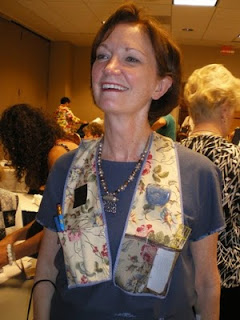






Monthly programs for garment sewers aspiring to sew at the couture level. See us also on Facebook: https://www.facebook.com/groups/CityWideCoutureAtlanta/







 Here is what Jenny has to say about her vest challenge:
Here is what Jenny has to say about her vest challenge: This is what Martha says about her vest:
This is what Martha says about her vest: 







Here are some helpful tips to keep in mind:
These techniques are all about the fabric, so find one that’s interesting with unraveled edges. For example, a fabric with different color warp and weft yarns has an entirely different look when unraveled.
fringe
Here is my take on Kenneth King’s technique for making a brush fringe.
(Source: Threads Magazine, Issue #137)

Think of this fringe technique as a fabric sandwich. You have a top and bottom piece of fashion fabric that have fringed edges and a stabilizing layer in-between.
Here are the steps:
 Sew the support layer to the wrong side of the top layer on the seam allowance.
Sew the support layer to the wrong side of the top layer on the seam allowance.frayed edge
Here is my interpretation of Louise Cutting’s technique for making a frayed raw edge.
(Source: Threads Magazine, Issue #121)
Think of this edge as a frayed trim. You have a bias strip with frayed raw edges sewn to the back of your fashion fabric and flipped to the front. Experiment with different fabrics to find the most appealing combination - sheers seem to work especially well with this technique.
Don’t give up couture techniques because you’ve chosen a simple embellishment. Use an underlining if your fabric calls for it, it can add to the trim effect. And if you’re using this edge in lieu of a facing you can add a stay tape to stabilize the edge, too.
Here are the steps:




If you want to add stay tape to the edge, carefully sandwich it under the fashion fabric on the right side before understitching, butting it against the fold. (Or baste it in place on the front side, with one edge on the previous stitching line before turning the seam allowance to the front.)




When attaching binding (bias or straight) to an edge that is continuous, it is often desirable to avoid bulk where possible in the joining of individual pieces. This occurs when there is too little length in your fabric to avoid piecing. The typical way to join the short pieces to make one long piece is to cut each end at a 45 degree angle and stitch the angled ends together. The can be accomplished in a variety of ways. My favorite is to start with the ends squared off as if you were going to simply sew a seam at a 90 degree angle to the length of the binding. Then I lay the two pieces right sides together at a 90 degree angle and stitch across the diagonal of the square formed. NOTE: pin along the proposed stitching line and open it out to make sure you are sewing the CORRECT diagonal. One makes a miter which is not desired here. The other diagonal is the correct one. You can start in one corner, take a few stitches, and then hold the thread tale in the direction you are sewing so that it forms a visible diagonal to follow as you stitch. Then just cut off the excess triangles on each piece.

If you are attaching the binding to a piece that is continuous in that it does not have a specific start and end place, then it is also desirable to attach the beginning and ending of the binding in a similar diagonal manner. This is important, for example, when you are binding a quilt, or even the outer edge of a jacket when the finished edge runs along the hem, front edges and neckline. Simply sewing the two ends together in at a 90 degree angle from the length of the binding creates a lot of bulk and is also a fairly weak seam.

To join these two pieces in a perfect diagonal, first begin sewing with a generous tail left over at the beginning, say around 7”. Then sew around the object to within about 10” of the beginning of your sewing. Remove the piece from your sewing machine. Now you need only measure the width of the binding piece. This is the amount of overlap you'll need for the perfect diagonal (curly braces in figure 2). For example, if your binding starts out as 2” wide, then the overlap between the beginning of the binding and the end should be exactly 2”. Once you have the overlap cut precisely, then fold one end at a right angle and finger press. Slide the other piece under it. It is now possible to see where the diagonal stitch will go. You may wish to mark it with a pencil or, as indicated above, use the thread tail on your sewing machine to guide you to a perfect 45 degree angle. Finished join should look like the drawing below. You can now finish attaching the binding to the piece, fold and finish as you normally do with a binding.
 See you next time, Martha
See you next time, Martha
